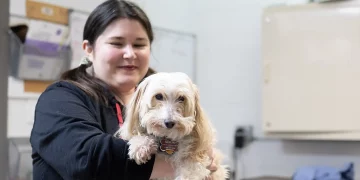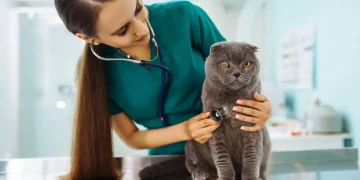Introduction:
Grooming is often seen as a luxury or a treat for pets, but it’s actually a crucial part of their health and well-being. Regular grooming goes beyond just keeping your pet looking cute and fresh – it plays an essential role in maintaining their overall health. Whether you have a dog, cat, or any other pet, grooming should be a regular part of their routine, especially for long-haired or thick-coated breeds. In this article, we’ll explore why grooming is necessary for pets and what benefits it provides to both their physical and emotional health.
1. Improving Physical Health
a. Preventing Mats and Tangles
For pets with longer fur or dense coats, mats and tangles can form if their hair isn’t regularly brushed. These tangles not only make your pet uncomfortable, but they can also cause painful skin irritations or sores. Regular brushing helps keep the fur untangled and smooth, reducing the risk of mats and the discomfort they bring.
- Benefit: Regular brushing helps prevent the formation of mats, keeping the coat healthy and reducing discomfort for your pet.
b. Controlling Shedding
Pets shed fur naturally, but regular grooming helps control how much hair they shed around your home. Brushing removes loose hair before it falls off, which reduces the buildup of hair on furniture, carpets, and clothing.
- Benefit: Regular grooming helps keep shedding under control, reducing the need for frequent cleaning around the house.
c. Ear Cleaning and Prevention of Infections
Ear health is another important aspect of grooming, especially for breeds with floppy ears. Without regular cleaning, wax buildup, dirt, and moisture can accumulate in the ears, leading to ear infections. Grooming includes cleaning the ears properly to avoid these issues.
- Benefit: Regular ear cleaning reduces the risk of ear infections, which can be painful and difficult to treat if left unchecked.
d. Nail Trimming
Untrimmed nails can lead to discomfort and health problems, such as difficulty walking, nail breaks, or joint strain. Overgrown nails can also become painful if they curl and dig into your pet’s paw pads.
- Benefit: Regular nail trimming ensures that your pet’s nails are kept at a healthy length, preventing discomfort and potential injury.
e. Skin Health
When grooming your pet, you can check for skin problems such as hot spots, rashes, flea infestations, or infections. Regular grooming sessions give you the opportunity to catch any skin issues early, making treatment more effective.
- Benefit: Grooming helps you identify skin conditions early, leading to faster treatment and better outcomes for your pet’s health.
f. Dental Hygiene
While regular tooth brushing is crucial, some grooming routines also incorporate teeth cleaning. Dental hygiene in pets is often neglected, leading to plaque buildup, bad breath, and even gum disease. Many professional groomers offer dental services to help maintain your pet’s oral health.
- Benefit: Regular teeth cleaning as part of grooming helps maintain oral health, prevent gum disease, and keep your pet’s breath fresh.
2. Enhancing Emotional and Psychological Well-being
a. Bonding Time
Grooming can be a bonding experience for both you and your pet. Regular grooming provides you with a chance to spend quality time together, which strengthens your relationship and helps build trust. The grooming process also allows you to check for any changes in your pet’s body, such as lumps, bumps, or unusual sensitivity, which can indicate health issues.
- Benefit: Grooming strengthens the emotional bond between you and your pet, making them feel safe and cared for.
b. Stress Relief
For many pets, the grooming process can be calming and relaxing, especially when it is done with care and attention. Brushing and petting release endorphins, which help reduce stress and anxiety. Regular grooming helps your pet become accustomed to being handled, making the process easier and less stressful over time.
- Benefit: Regular grooming helps reduce stress and anxiety, providing a comforting routine for your pet.
c. Behavioral Benefits
Many pets, especially dogs, benefit from regular grooming in terms of behavioral improvements. When pets are used to being handled and groomed, they become more tolerant of other activities, such as visiting the vet or going on car rides. Additionally, grooming can help with socialization, as it introduces your pet to new experiences in a safe and controlled environment.
- Benefit: Regular grooming can contribute to better behavior and socialization skills, making your pet more adaptable to different situations.

3. Supporting Overall Health and Hygiene
a. Fleas and Parasite Control
While grooming, you can check for fleas, ticks, and other parasites that may be affecting your pet. These pests can cause discomfort, transmit diseases, and lead to more severe health issues if left untreated. Professional groomers often have the expertise to detect and remove pests that may be hiding in your pet’s fur.
- Benefit: Regular grooming helps detect fleas and other parasites early, leading to prompt treatment and better overall hygiene for your pet.
b. Reducing Allergens
Pet hair and dander can contribute to allergies, both for the pet and the people living with them. Regular grooming, especially brushing, helps remove loose hair and dander from your pet’s coat, reducing the amount of allergens in your home.
- Benefit: Grooming can help reduce allergens, improving both your pet’s health and the comfort of people with sensitivities to pet hair and dander.
4. When Should You Start Grooming Your Pet?
It’s important to start grooming your pet early, so they get used to the process and understand that it’s a positive experience. Puppies and kittens should be introduced to grooming gently, gradually getting them accustomed to brushing, nail trimming, and other grooming tasks. The earlier they learn to accept grooming, the easier it will be for both you and your pet as they grow older.
5. What Does Regular Grooming Include?
Regular grooming doesn’t just mean brushing your pet’s coat – it includes a variety of tasks aimed at keeping your pet healthy and clean. Some of the key grooming services include:
- Brushing: To remove loose hair, dirt, and tangles, and to keep the coat shiny and healthy.
- Nail trimming: To maintain proper nail length and prevent injury.
- Ear cleaning: To remove dirt and prevent infections, especially in breeds prone to ear problems.
- Teeth cleaning: To prevent plaque buildup and oral diseases.
- Bathing: To keep your pet clean and fresh, especially if they are prone to skin conditions.
- Anal gland expression: Some pets require regular expression of their anal glands to prevent discomfort or infection.
6. When Should You Seek Professional Grooming Services?
While many grooming tasks can be done at home, there are instances when professional grooming services are necessary. Pets with matted fur, specific breed grooming requirements, or behavioral issues may benefit from professional grooming. A trained groomer can also handle tasks such as anal gland expression, flea treatments, or complex grooming cuts that may be difficult for pet owners to manage on their own.
7. Conclusion:
Regular grooming is a vital aspect of pet care that goes beyond just making your pet look good. It helps improve your pet’s health, reduces stress, and strengthens your bond with them. Grooming provides numerous benefits, including preventing mats and tangles, controlling shedding, maintaining skin and coat health, and ensuring your pet’s overall hygiene. Whether done at home or professionally, grooming should be an integral part of your pet’s routine to keep them happy, healthy, and comfortable.























































